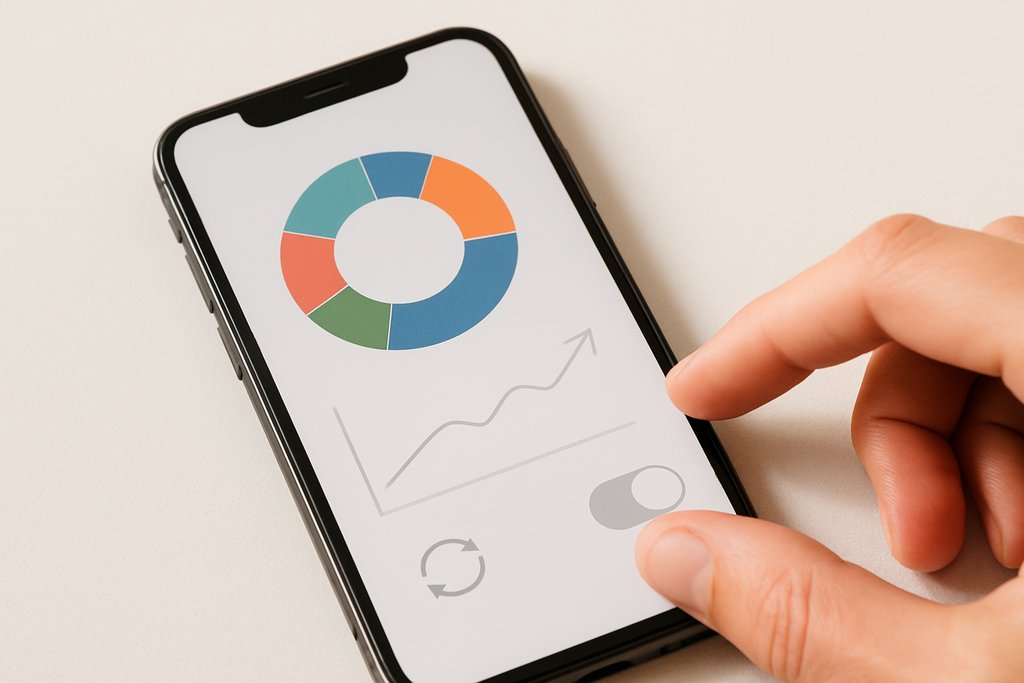Autopilot Investment App: A Complete Hands-Off Guide
Learn how an autopilot investment app turns clear rules into continuous execution so your portfolio follows the plan without constant screen time.

Table of contents
- Why invest on autopilot
- What is an autopilot investment app
- How an investment autopilot app works
- Choosing the right app for your style
- Strategy design that survives markets
- Real-time triggers beyond price
- From idea to autopilot with Obside
- Benefits and key considerations
- Use cases and templates
- Why Obside fits the brief
- Conclusion and next steps
- FAQ
- Related articles
Autopilot investment app: the complete guide to hands-off, rules-based investing
If you search for autopilot investment app, you probably want your portfolio to run on clear rules so it can react faster than you can without constant screen time. Markets move at all hours, news hits when you least expect it, and emotions often lead to poor decisions. An autopilot approach gives you a way to encode your plan, remove hesitation, and execute consistently.

What is an autopilot investment app?
An autopilot investment app is a tool that lets you define rules for investing and then executes those rules automatically. Instead of manually buying or selling during a volatile day, you set conditions such as prices, technical indicators, or even news events. When those conditions are met, the app alerts you or places orders through your connected broker or exchange.
There is a wide spectrum inside this category. Some tools look and feel like classic robo-advisors that keep your portfolio aligned to a risk profile through rebalancing. Others are closer to algorithmic trading platforms that allow deeper customization, multi-asset coverage, and event-driven logic. For a quick primer on traditional robo-advisors, see Investopedia’s explainer on robo-advisors.
The core idea is the same across the spectrum. You translate your investment plan into if-then rules, you backtest those rules on historical data to check if they make sense, and then you let the app monitor markets in real time to run the plan for you. If you are mapping out your approach, our guide on investment strategies you can build and automate is a practical companion.
How an investment autopilot app works under the hood
Any credible autopilot investing app brings together five building blocks. First, it ingests data from markets, including prices, volumes, and indicators, as well as non-price signals like earnings releases, economic data, or curated news feeds. Second, it evaluates your conditions on a schedule or on every new tick, depending on the asset and timeframe. Third, it manages risk rules such as position sizing, stop-loss, take-profit, and trailing stops. Fourth, it routes orders to your broker or exchange and tracks fills, slippage, and fees. Finally, it records everything in an audit trail so you can understand performance and refine decisions.
Backtesting ties these pieces together before you ever go live. You apply your rules to historical data and review metrics such as win rate, average gain and loss, drawdown, and exposure. If you are new to the concept, here is Investopedia’s overview of backtesting.

A modern platform can run all this at high speed with no code. That is exactly where Obside stands out. Obside is a financial automation platform that turns plain-language instructions into market actions. You chat with Obside Copilot, describe what you want to do, and it builds the rules, runs ultra-fast backtests, and automates execution through your connected brokers and exchanges. You can set alerts, trigger orders, or manage an entire portfolio based on price thresholds, technical signals like RSI or MACD, real-time news, and even macroeconomic data.
Choosing the right autopilot investing app for your style
Not every investor needs the same toolkit. The best autopilot investment app for you depends on the assets you trade, the level of control you want, and how you think about risk. If you trade a handful of ETFs and want periodic rebalancing, a simpler setup may be enough. If you want to react to earnings surprises, commodity shocks, sentiment shifts, or cross-asset signals, you need event-driven capabilities and a robust rule engine.
You will want transparency when defining your rules. It should be clear which trigger fired, why an order was placed, and how the risk controls were applied. It also helps to have a marketplace of strategies or templates so you can start from proven ideas rather than a blank canvas. Obside includes a marketplace where traders can share strategies, and it gives you the ability to adapt them to your own risk level.
Execution quality matters as well. The app should handle order types supported by your broker, respect your slippage limits, and throttle orders if the market becomes illiquid. Finally, you need speed in backtesting so you can iterate quickly. Obside’s backtesting is built for fast experimentation, which means you can validate ten variations of an idea in minutes instead of waiting overnight. If you are weighing options across markets, read our forex trading guide for currency-specific considerations.
Strategy design that survives real markets
It is easy to create a rule that looks great on a chart and then fails in live conditions. Designing for durability is about building in risk limits and avoiding overfitting.
Start with your edge. If you believe momentum persists, define a momentum rule with clear entry and exit, for example an entry when price crosses above a moving average and a confirmed trend filter such as a positive MACD or a higher high. If you prefer mean reversion, define bands or thresholds where you buy weakness and scale out on a return to the mean. For technical indicators, a quick refresher on the Relative Strength Index can be useful: what the RSI measures and how traders use it.
Keep your logic simple enough to explain in one sentence.
Position sizing is often overlooked. Decide how much of your portfolio each rule can allocate, and cap the number of concurrent positions if you run a basket strategy. Apply stop-loss and take-profit levels that reflect the volatility of your asset. A fixed 2 percent stop is not meaningful when volatility jumps. Many investors use average true range for dynamic stops so risk adapts to conditions.
Keep your logic simple. Complexity tends to overfit historical noise. If your backtest looks perfect, it usually means you insulated it from reality with too many conditions. Stress your rule by changing parameters and timeframes to see if it still behaves sensibly. Diversify across assets and timeframes to reduce the risk that a single regime change derails your account. For a broader foundation, see our practical guide on how to invest.
Real-time triggers beyond price alone
The biggest leap from classic chart-based trading to autopilot investing is event-driven execution. You are no longer limited to price crossing a line. You can react to information like earnings releases, macro prints, or sector headlines.
Obside was designed for this. You can say, alert me if Bitcoin rises above a threshold and daily volume doubles, or notify me if RSI crosses 70 on EUR/USD while MACD turns bearish. You can also go beyond charts. Ask to sell a stock if new tariffs are announced for its sector, or to buy a commodity when a hurricane disrupts supply. You can factor in volatility spikes, and you can link rules to specific news like a product launch from Apple or a new model announcement from an AI company. This combination of price action and verified events gives you more control over when and why your strategy deploys capital.
If you are exploring where AI can help most, these ideas pair well with practical AI investing strategies that go beyond buzzwords.
Practical, step-by-step: from idea to autopilot with Obside
Let’s turn an idea into a running strategy. First, create a free account on Obside at beta.obside.com/register and connect your broker or exchange through secure API access. Once connected, open Obside Copilot and describe your plan in plain language. For example, you might write, buy 50 dollars of Bitcoin every Monday at 10:00 AM, or, when the Supertrend turns bullish on the 2 hour chart and RSI is below 70, buy, then set a trailing stop at 5 times ATR on the 2 hour chart and take profit at 10 percent.
Obside will translate your description into a set of conditions and risk rules. Before going live, run a backtest to see how it would have performed historically. You can ask the Copilot to try variations, such as different timeframes or a stricter RSI threshold, and compare drawdown, hit rate, and average return. If a rule looks too perfect, try loosening a parameter or switching markets to test its robustness.
When you are comfortable, switch to paper trading or live with a small allocation. Keep an eye on execution metrics like slippage and average fill time. As the strategy runs, you can refine it with new filters. For instance, you might add a macro condition, rebalance your portfolio when volatility spikes, or pause entries during major earnings weeks.
Alerts: “Alert me if Bitcoin rises above 150,000 and daily volume doubles.”
Actions: “Buy 50 dollars of Tesla if Elon Musk tweets about it.”
Full strategies: “When Supertrend turns bullish on 2h and 8h and RSI is not overbought, buy and add a 5 ATR trailing stop.”
Obside makes this workflow smooth because everything is conversational. You do not need to know how to code. You simply describe what you want, from alerts to full automation. You can set rules like buy 1000 dollars of Bitcoin if the price is below a threshold, sell all positions if the S&P 500 drops by 10 percent, or buy 50 dollars of Tesla if a specific social trigger occurs. You can also monitor a basket of assets and keep a fixed allocation such as 50 percent Bitcoin, 25 percent Ethereum, and 25 percent USDC, with automatic rebalancing.
Benefits of an autopilot investing app, and key considerations
The benefits are straightforward. You gain time because you are not tethered to screens. You remove emotional swings from your decisions and follow the plan you designed. You respond faster to events because the system checks conditions continuously. You can diversify across strategies, assets, and timeframes because automation scales more easily than manual trading. Most importantly, you gain testability. If your results drift from the backtest, you know which part to adjust.
- Save time by automating routine decisions
- Reduce emotional bias with rule-driven execution
- React to price, news, and macro in real time
- Scale across assets and strategies with control
There are important considerations. Markets carry risk, and no rule guarantees profit. Backtests can overstate performance if data quality is poor or if slippage and fees are not accounted for. Models that fit the past too closely can fail when regimes change. Execution can suffer in illiquid names or during volatile events. The solution is realistic testing, strict risk controls, and incremental scaling.
Finally, plan for maintenance. Even a simple dollar-cost averaging rule benefits from periodic review. Complex systems that react to events or volatility need monitoring to ensure the logic still matches your goals. Build a habit of reviewing drawdowns, trade distribution, and the ratio of winners to losers. Make small improvements often rather than large rewrites after a setback.
Use cases and templates you can deploy today
Dollar-cost averaging is the simplest investment autopilot. You buy a fixed amount on a schedule without trying to time the market. A rule like buy 50 dollars of Bitcoin every Monday at 10:00 AM eliminates decision fatigue and enforces consistency.
Trend following is popular for its clarity. You might enter when the Supertrend turns bullish on a higher timeframe while RSI is not overbought and a longer Supertrend also confirms the direction. You can exit when these conditions reverse and add a trailing stop based on volatility. This gives you a repeatable blueprint for riding moves without constant guessing.
Mean reversion works well when markets oscillate in ranges. Buy when price drops far below a moving average and exit on a return toward that average. Combine this with a filter that avoids directions that conflict with a higher timeframe trend so you do not fight a strong move.
Event-driven rules can complement both approaches. For instance, rebalance your allocations when volatility spikes, or reduce exposure if a key macro event comes in far from consensus. You can also set alerts around company announcements. For example, alert me if Apple announces a new product, or tell me when a specific AI company releases a new model. With Obside, you can connect these alerts to actual orders when you are ready. If equity themes interest you, you might also explore investing in AI stocks alongside rules-based automation.
Why Obside fits the autopilot brief
Obside exists to remove friction between idea and execution. You can create smart alerts, trigger automatic orders, or manage entire portfolios based on your own rules. You can combine price conditions with technical indicators, news, and macroeconomic data so that your strategy truly reflects how you think markets move. Obside’s ultra-fast backtesting lets you validate in seconds. Once you are satisfied, Obside runs it for you with your connected brokers and exchanges. Recognized by professionals and awarded the Innovation Prize 2024 at the Paris Trading Expo, Obside has the speed and flexibility many investors want in an autopilot investment app. Explore the platform at obside.com or open an account at beta.obside.com/register to try it yourself.
Conclusion: your next three steps to go from reading to doing
You now have a clear picture of what an autopilot investment app is, how it works, and how to design a strategy that fits your style. The fastest path from learning to results is to take these steps. First, write down a simple rule you can explain in one sentence. Second, turn that rule into a backtest and stress it by changing parameters and markets. Third, deploy it with small size, monitor results, and refine weekly. If you want to skip the technical hurdles, try Obside. Describe your rule to the Copilot, validate in seconds, and let the system execute while you focus on the bigger picture.
FAQ
Is an autopilot investment app the same as a robo-advisor?
Not exactly. A robo-advisor automates portfolio allocation and periodic rebalancing based on a risk profile. An autopilot investment app can do that, but it also lets you create custom event-driven rules, technical conditions, and strategy logic that execute in real time. Think of robo-advice as a subset of what a modern autopilot platform can offer.
Do I need coding skills to use an autopilot investing app like Obside?
No. Obside was built so you can describe your idea in plain language. You might say, buy when there is a bullish divergence on RSI on a 15 minute chart, set a stop on the low of the day, take profit at 10 percent, and Obside converts it into a runnable strategy. You can still go deep if you choose, but coding is not required.
How much capital do I need to start?
There is no single number. Many investors begin with small, consistent allocations, for example a weekly dollar-cost average or a modest fraction of their account for a single strategy, and then scale as they build confidence. The key is to size positions so that normal drawdowns are tolerable and do not trigger emotional decisions.
Can I run multiple strategies at once?
Yes. A major advantage of using an investment autopilot app is the ability to diversify across strategies. You might run a trend strategy on equities, a mean reversion rule on forex, and a scheduled accumulation on crypto. Obside lets you manage all three in parallel and cap their allocations to control total risk.
How do I avoid overfitting my strategy?
Keep your rules simple, use out-of-sample tests, and include realistic assumptions for fees and slippage. Stress the parameters, for example change the timeframe or indicator thresholds, and check that performance is still reasonable. Favor robustness over perfection in backtests.
